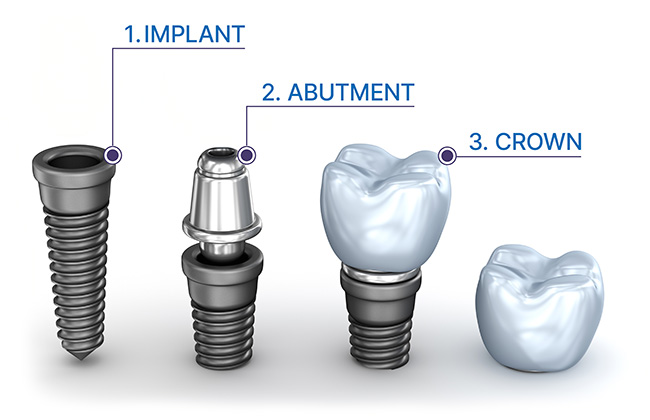Single-tooth dental implants are often the best replacement option for patients who are missing only one tooth or have a tooth that needs to be removed due to damage or decay. Dental implants are a permanent solution for replacing a tooth, and they look, feel, and function just like natural teeth.
A single-tooth implant is made up of three parts:

At your pre-surgical appointment, detailed 3D digital scans of your mouth will be taken. The dentist will use this data to determine optimal implant placement and, in conjunction with the Hybridge Smile Design Software, to design a new crown that will blend in seamlessly with its neighboring teeth.
On the day of the procedure, if you need a tooth removed, it will be carefully extracted. The implant post will be surgically placed into your jawbone. If the new tooth is part of your “smile line,” you will receive a temporary tooth attached to your new implant, so you won’t have a gap in your smile while the implant site heals.
After about three months, once the implant has fully integrated with your jawbone, a new digital scan will provide the information necessary to complete the design of your permanent crown. To ensure your new tooth will fully meet your aesthetic expectations, you’ll be able to preview the design and request any changes before it is finalized.
One month later, your beautiful and durable final crown will replace the temporary tooth, restoring full chewing ability. This final step completes your smile restoration, providing long-lasting function and a natural appearance. With proper care and maintenance, your new crown can last for many years to come.
Unlike a traditional dental bridge, an implant does not harm neighboring teeth—it is a “one-tooth solution for a one-tooth problem.”
Dental implants cannot get cavities or decay. But just like natural teeth, they still need to be cleaned daily to keep your gums healthy and your smile strong.
They can be brushed and flossed around just like natural teeth. No special cleaning tools are needed—just your regular toothbrush, floss, and good daily habits to keep everything healthy and clean.
With proper care and regular dental checkups, implants have been shown to last for 40 years or more, making them one of the most durable and long-lasting tooth replacement options available.
Due to their longevity, dental implants can cost far less in the long run than other tooth replacement options.
Unlike a partial denture, the implant fuses with your jawbone, so it will not come loose, and it cannot be removed except by a doctor.
Bone loss in the jaw occurs when a tooth is missing due to a lack of stimulation provided by full-force chewing. Dental implants stimulate the jawbone to prevent bone loss and maintain the facial contour’s appearance.
A dental implant prevents neighboring teeth from shifting out of place over time to fill the gap left by a missing tooth. Shifted teeth can cause poor bite alignment, difficulty eating, and disorders with the jaw joint (TMJ).
Replacing a missing tooth with an implant can often improve one’s speech by providing a stable structure for the tongue and lips to form sounds accurately. Dental implants also help restore natural tooth alignment—essential for proper articulation—and fill gaps that might otherwise cause airflow disruptions and affect pronunciation.
Dental implants restore confidence and self-esteem. With your new implant, you can eat comfortably again and smile without worry or embarrassment. Many patients say it feels just like having their natural tooth back.
When an individual tooth is broken down or damaged to the point that it cannot be saved—or when a single tooth has already been lost—a single-tooth implant is almost always the optimal solution for replacing it. If the neighboring teeth are damaged but still salvageable, a traditional dental bridge may also be an option, but it won’t last as long or clean as easily as a single-tooth implant.
Hybridge uses biocompatible titanium for the implant post and implant abutment. Titanium is widely considered the best metal to use for prosthetics; it doesn't react with bodily fluids, doesn’t cause harmful immune responses, integrates well with bone, and can handle repeated stress without breaking down.
The type of material used to make the crown often varies and can depend upon its location in the mouth, as well as other factors. Zirconia is commonly chosen for back teeth due to its strength, while dental porcelain is often used for front teeth because of its exceptionally natural appearance.
The first step in getting a single implant is a consultation and examination with an experienced implant dentist. The dentist will perform detailed diagnostic work, which typically includes taking a 3D X-ray and an intraoral scan. They will tell you if an implant is the best solution for your unique situation. On the day of the procedure, if your damaged tooth is still present, the doctor will extract it. The doctor will surgically place the implant post. You may receive a temporary tooth on the same day. A few months later, after the implant has completely integrated with your jawbone, the doctor will remove your temporary tooth and replace it with a strong and beautiful permanent crown.
Consult with a Hybridge doctor to understand your personalized treatment options for your perfect smile.
Book Your Consultation Today